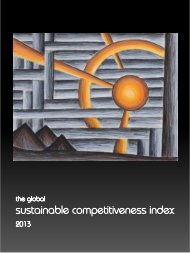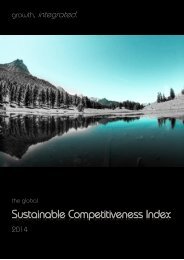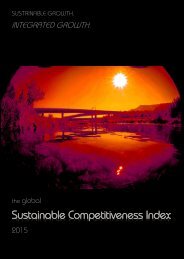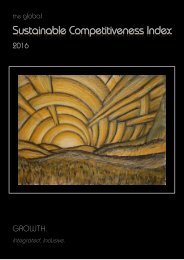Global Competetiveness Report
Create successful ePaper yourself
Turn your PDF publications into a flip-book with our unique Google optimized e-Paper software.
Country rankings<br />
Natural Capital<br />
Natural Capital Sustainability<br />
Country Rank Score<br />
Panama 89 40.4<br />
Serbia 90 40.4<br />
Benin 91 40.4<br />
South Korea 92 40.4<br />
Honduras 92 40.4<br />
Romania 94 40.2<br />
Mauritius 95 40.0<br />
Slovenia 96 40.0<br />
Bulgaria 97 39.9<br />
Philippines 98 39.8<br />
Qatar 99 39.8<br />
Djibouti 100 39.7<br />
South Africa 101 39.6<br />
Luxembourg 102 39.6<br />
Kyrgistan 103 39.2<br />
Switzerland 104 39.1<br />
Togo 105 38.5<br />
Slovakia 106 38.2<br />
Saudi Arabia 107 37.8<br />
El Salvador 108 37.5<br />
Albania 109 37.3<br />
Poland 110 37.3<br />
Mauritania 111 37.2<br />
Kuwait 112 37.2<br />
Sri Lanka 113 37.1<br />
Dominica 114 37.0<br />
Senegal 115 36.8<br />
Georgia 116 36.7<br />
Chile 117 36.6<br />
Spain 118 36.1<br />
United Kingdom 119 36.1<br />
Niger 120 36.0<br />
Turkmenistan 121 35.7<br />
Mexico 122 35.7<br />
North Korea 123 35.7<br />
Macedonia 124 35.4<br />
Algeria 125 35.3<br />
Ukraine 126 35.3<br />
Timor-Leste 127 35.2<br />
Malta 128 35.1<br />
Bahamas 129 34.8<br />
Seychelles 130 34.7<br />
Thailand 131 34.5<br />
Oman 132 34.4<br />
Negative efficiency incentives<br />
Countries have a variety of tools at their<br />
disposal to increase the efficiency of natural<br />
capital usage and so achieving sustainable<br />
development in their specific natural context.<br />
These tools include, amongst others:<br />
• Setting mandatory efficiency standards<br />
(possibly coupled with fines for noncompliance)<br />
• User-pays principles – defining prices of<br />
resources (e.g. water) that reflect the<br />
inclusive value of the resource or<br />
internalizes non-financial depletion and/or<br />
pollution costs. This measurement can be<br />
coupled with positive incentives, whereby<br />
the revenues so gained are redistributed in<br />
relevant R&D efforts, support for<br />
technology, subsidies, or other programs<br />
• Introduction of environmental regulations<br />
• Designation of protected areas<br />
• Designation of sustainable development<br />
demonstration projects and areas<br />
• Polluter pays principles.<br />
• As a drastic measurement of last resort:<br />
introduction of contingents<br />
The danger of many of the above<br />
measurements lies in the details and<br />
comprehensiveness of policies, and have to<br />
be embedded in the wider national context<br />
in order to avert potential negative social side<br />
effects and the unintentional development of<br />
inequality in terms of income levels.<br />
In order to guarantee long-term<br />
sustainability, economic development<br />
considerations have to be taken into account<br />
as well.<br />
36<br />
The <strong>Global</strong> Sustainable Competitiveness Index








